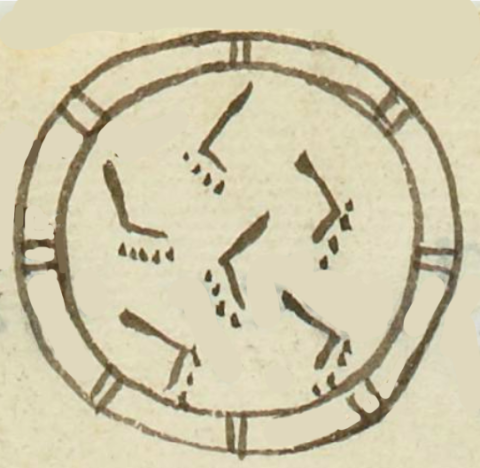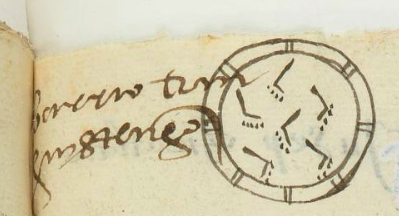Tianquiztenco (MH778r)
This black-line drawing of the compound glyph for the place name Tianquiztenco (“At the Edge of the Market") shows a bird's eye view of a marketplace (tianquiztli), or tianguis in contemporary Spanish. The sign consists of a circle with a border on the perimeter that has seven double hatch marks evenly spaced around. Inside the circle are seven somewhat scattered footprints, implying the movement of people around the marketplace, but also providing the phonetic value for -quiz (from the verb quiza, to emerge).
Stephanie Wood
Footprint glyphs have a wide range of translations. In this collection, so far, we can attest to yauh, xo, pano, -pan, paina, temo, nemi, quetza, otli, iyaquic hualiloti, huallauh, tepal, tetepotztoca, totoco, otlatoca, -tihui, and the vowel "o." Other research (Herrera et al, 2005, 64) points to additional terms, including: choloa, tlaloa, totoyoa, eco, aci, quiza, maxalihui, centlacxitl, and xocpalli.
Stephanie Wood
barrio tian
guistengo
barrio, Tianquistenco
1560
Jeff Haskett-Wood
mercados, tianguis, nombres de barrios, círculos, huella, huellas, step, steps, paso, pasos, footprint, footprints, icximachiyotl, xocpalli, icxipamitl, topónimos, nombres de lugares
This detail of a tianquiztli (market place) from the Florentine Coex (Book 8, f. 50v) shows a glyph similar to what is seen above. It is a bordered circle with footprints that show movement across the space. It also has hash marks inside the perimeter, perhaps suggesting that the larger space has internal divisions (for vendors?). See the Digital Florentine Codex (Getty Research Institute): https://florentinecodex.getty.edu/book/8/folio/50v/images/aeabee3d-1ce7-...

tianquiz(tli), marketplace, https://nahuatl.wired-humanities.org/content/tianquiztli
-tenco, at the edge of, https://nahuatl.wired-humanities.org/content/tenco
A la Orilla del Tianguis (nombre de barrio)
Stephanie Wood
Matrícula de Huexotzinco, folio 778r, World Digital Library, https://www.loc.gov/resource/gdcwdl.wdl_15282/?sp=632&st=image
This manuscript is hosted by the Library of Congress and the World Digital Library; used here with the Creative Commons, “Attribution-NonCommercial-ShareAlike 3.0 License” (CC-BY-NC-SAq 3.0).






